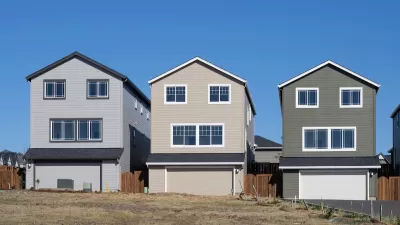As the housing market roars back to life, the price of "dirt", or developable land, is surging in America's most desirable areas - including the outer suburbs. A shortage of lots is said to be hampering the housing recovery.
"The latest land rush is in full swing," writes Shaila Dewan, "as developers realize that they have failed to feed the zoning, permitting and mapping pipeline, which can take months or years to turn raw fields into buildable lots. They are realizing another thing, too: they have been sorely missed."
“For the first time, I’ve seen cities want to work to help figure it out, rather than doing us a favor all the time to let us develop,” said Scott Carlston of Hunter Emerson, a development partnership.
“We have gone from a situation where five years ago everyone was saying, ‘There’s too many lots,’ to today, builders are literally crying on our shoulder saying, ‘There’s not enough lots. We can’t find any,’” said Bradley F. Hunter, the chief economist at MetroStudy.
FULL STORY: Prices Are Rising for New Homes, and the Land They Are Built On

Trump Administration Could Effectively End Housing Voucher Program
Federal officials are eyeing major cuts to the Section 8 program that helps millions of low-income households pay rent.

Planetizen Federal Action Tracker
A weekly monitor of how Trump’s orders and actions are impacting planners and planning in America.

Ken Jennings Launches Transit Web Series
The Jeopardy champ wants you to ride public transit.

Washington Legislature Passes Rent Increase Cap
A bill that caps rent increases at 7 percent plus inflation is headed to the governor’s desk.

From Planning to Action: How LA County Is Rethinking Climate Resilience
Chief Sustainability Officer Rita Kampalath outlines the County’s shift from planning to implementation in its climate resilience efforts, emphasizing cross-departmental coordination, updated recovery strategies, and the need for flexible funding.

New Mexico Aging Department Commits to Helping Seniors Age ‘In Place’ and ‘Autonomously’ in New Draft Plan
As New Mexico’s population of seniors continues to grow, the state’s aging department is proposing expanded initiatives to help seniors maintain their autonomy while also supporting family caregivers.
Urban Design for Planners 1: Software Tools
This six-course series explores essential urban design concepts using open source software and equips planners with the tools they need to participate fully in the urban design process.
Planning for Universal Design
Learn the tools for implementing Universal Design in planning regulations.
Heyer Gruel & Associates PA
Ada County Highway District
Institute for Housing and Urban Development Studies (IHS)
City of Grandview
Harvard GSD Executive Education
Toledo-Lucas County Plan Commissions
Salt Lake City
NYU Wagner Graduate School of Public Service



























